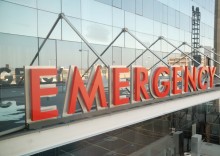Ten Drugs Cause Majority of ER Visits in Adults for Adverse Psych Med Effects

Nearly 90,000 adults go to emergency rooms each year for side effects of psychiatric medications, and a few specific drugs may be to blame for 57% of those visits, a new study has found.
The findings suggest targets for improvement, Dr. Lee Hampton of the US Centers for Disease Control and Prevention in Atlanta, Georgia and his team wrote online July 9 in JAMA Psychiatry. The study first gave an overview of emergency department visits, showing that the nearly 90,000 visits account for nearly 10% of all visits for adverse drug effects.
Also, nearly half of the patients were ages 19 to 44 years, and one in five required hospitalization. The study then broke down the emergencies by the class of drug implicated. It estimated that sedatives and anxiolytics were most often to blame, causing nearly 31,000 annual emergency department visits. Following those, antidepressants account for more than 25,000 visits, antipsychotics for nearly 22,000, lithium salts for 3620 and stimulants for 2779.
The ten drugs that may be implicated in most of the emergencies are the following, according to the research team: zolpidem tartrate (Ambien), a sedative; quetiapine fumarate (Seroquel), an atypical antipsychotic; alprazolam (Xanax), an anxiolytic; lorazepam (Ativan), a sedative and anxiolytic; haloperidol, an antipsychotic; clonazepam, a sedative and anxiolytic; trazodone, an antidepressant, anxiolytic and sedative; citalopram hydrobromide (Celexa), an antidepressant; lithium salts, a mood stabilizer; and risperidone, an antipsychotic. The number one culprit on the list, zolpidem tartrate, accounts for more than 10,000 visits, while risperidone at number 10 accounts for nearly 3700, with the rest falling in between.
The authors say zolpidem tartrate is most often implicated in emergency room visits not because it is most likely to cause adverse reactions, but because it is prescribed often. The drug that caused the most adverse reactions is haloperidol, number five on the list. It is blamed for an estimated 43 emergency visits per 10,000 prescriptions and nearly 4900 per year.
Doctors may be able to reduce these side effects by cutting back on off-label prescriptions, the researchers write. Roughly two-thirds of prescriptions for typical and atypical antipsychotics are off-label and it is likely that many of those led to many of the emergencies, the researchers write. They have similar advice for reducing the number of zolpidem emergencies. Prescribe it only for insomnia, its approved usage, the researchers write.
In short, the struggle to reduce these kinds of adverse drug effects should start with the medications that cause the most emergencies, the researchers write. Dr. Hampton did not return requests for comment before publication.



